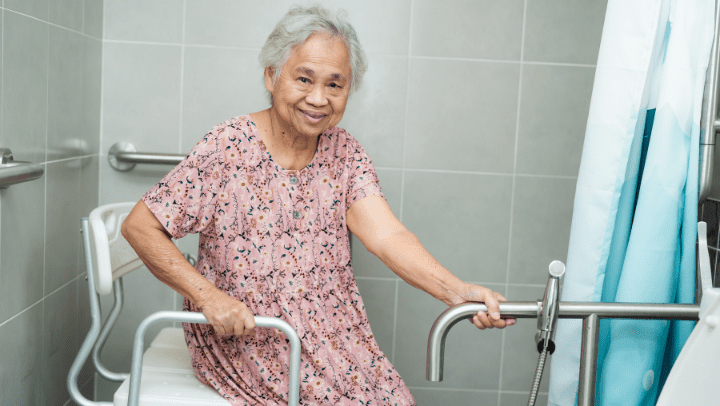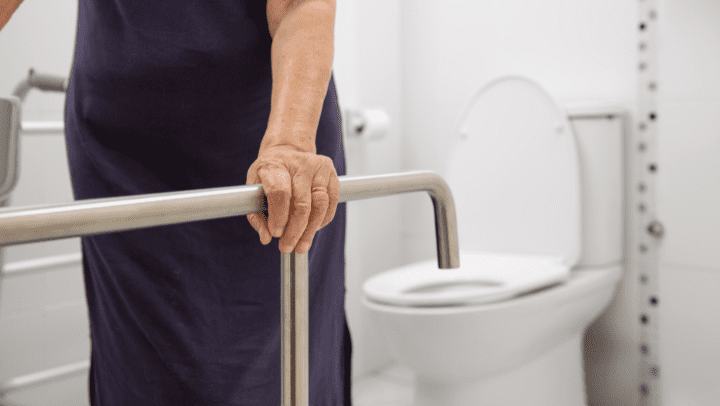
Bathroom safety is a top priority for families seeking a dementia care community in Eau Claire, WI. Most falls happen in bathrooms. Slippery floors and dim lighting create dangerous situations for seniors. These numbers might worry you, but there’s good news. Simple changes can reduce fall risks significantly. You might worry about your loved one’s safety now or want to plan ahead. A good understanding of bathroom safety helps your loved ones stay independent and gives you peace of mind.
Understanding Bathroom Fall Risks
Seniors face unique challenges with bathroom falls, especially when changing positions or using the facilities at night. Research shows all but one of these older adults living in communities fall at least once every year. About 60% of seniors need to use the bathroom twice or more during nighttime hours, which makes safety measures crucial.
The bathroom becomes risky because of several key factors:
- Physical Environment Hazards:
- Slippery surfaces and condensation
- Sharp edges and cramped spaces
- Dark conditions, mainly at night
- Spilled personal care items that create slick spots
Taking multiple medications can make seniors more vulnerable to falls. These medicines might cause:
- Vision problems or dizzy spells
- Sleepiness and reduced awareness
- Balance issues and muscle weakness
Poor lighting is one of the most important risk factors, especially when seniors use the bathroom at night. Research proves that rooms with 10 times more light saw 35% fewer falls in specific areas. Hospital reports also show that most falls happen during bathroom-related activities. Wet floors, tight spaces and complex movements make bathrooms unmatched in their risk level.
Essential Safety Modifications
Seniors need thoughtful bathroom modifications that target specific fall risks. These changes make a real difference in their independence and help prevent accidents.
Secure Footing Solutions: Non-slip mats with strong suction cups are one of the best ways to prevent bathroom falls. These mats give you good traction on wet surfaces and cover both tub and shower floors well. You can place these mats inside and outside the shower area to boost safety.
Structural Modifications: Walk-in tubs are the lifeblood of bathroom safety improvements. These specialized tubs don’t need you to step over high thresholds, which cuts down the risk of trips and falls. The installation has:
- Built-in seating that makes bathing comfortable
- Non-slip flooring
- Available entry points
- Quick-drain technology
Support Systems: Grab bars placed strategically near toilets and shower areas give you vital stability. These fixtures should be:
- Anchored properly into wall studs
- Set at the right heights
- Put in by qualified professionals
Toilet Accessibility: Raised toilet seats are a great way to get help for seniors with mobility challenges. These changes:
- Make sitting or standing less stressful
- Have secure locking mechanisms
- Give extra stability through attached arms
- Meet ADA compliance standards
Enhanced Lighting and Controls: Good bathroom lighting helps stop nighttime accidents. You might want to add:
- Motion-sensor lights
- Switches that are easy to reach
- Anti-scald faucets with lever handles
- Variable hot water safety controls
Floor Safety: Special floor treatments can protect you beyond standard non-slip mats. These treatments have:
- Water-resistant surfaces that increase friction
- Colors that contrast for better visibility
- Clean, dry floor maintenance steps
Building Confidence in the Bathroom
A senior’s psychological well-being plays a vital role in bathroom safety in any dementia care community. Research shows older adults often develop anxiety about future accidents after experiencing a fall. This anxiety leads to reduced activity and independence.
Building Physical Confidence: Seniors feel more secure with regular practice using safety equipment. Here are some confidence-building strategies:
- Start with supervised bathroom visits
- Practice using grab bars before you need them
- Learn how to use emergency alert systems
- Keep essential items within reach
Maintaining Independence: Personal care independence remains essential for emotional well-being. Seniors feel deflated when they struggle with simple bathroom tasks. These strategies can help:
- Use long-handled reaching devices for better control
- Take proper breaks during daily routines
- Make sure there’s enough light to see clearly
- Place commonly used items between waist and shoulder height
Creating Supportive Routines: Consistent routines build confidence naturally. These approaches work well:
- Plan bathroom visits when energy levels are high
- Set aside extra time for personal care
- Keep open communication about comfort levels
- Have emergency assistance ready
Preventing Anxiety: Fear of falling creates a cycle of decreased activity that increases fall risk. You can break this cycle by:
- Speaking openly about concerns
- Practicing safety measures often
- Building strength through approved exercises
- Staying socially connected
Preventing Accidents
Bathroom safety depends on preparation and prevention. Seniors can keep their dignity and independence while staying protected in their daily activities if you implement these safety measures and build proper routines. Physical safeguards combined thoughtfully with emotional support create an environment where seniors feel both secure and self-assured.
Note that confidence plays a key role in preventing accidents. Non-slip mats, grab bars, and proper lighting create a foundation for safe use in the bathroom. If you are looking for a memory care that prioritizes the well-being of your loved one, look into our community: Heritage Court Eau Claire. Contact us at (715) 831-8200 to schedule a tour!


